Impacts of Freezing Temperature Based Thermal Conductivity on the Heat Transfer Gradient in Nanofluids: Applications for a Curved Riga Surface
Abstract
1. Introduction
2. Physical Interpretation of the Results
2.1. The Velocity and Temperature Distribution
2.1.1. Effects of γ and S on F’(η)
2.1.2. Effects of k and n on F’(η)
2.1.3. Effects of R and M on β(η)
2.2. Streamlines Profile
2.3. Isotherms Profile
2.4. Thermophysical Characteristics
2.5. Nusselt Number and Skin Friction
2.6. Reliability of the Study
3. Materials and Methods
3.1. Model Formulation
3.1.1. Statement and Geometry of the Model
3.1.2. Governing Model and Similarity Transformations
3.1.3. Effective Nanofluid Models
3.1.4. Nondimensional Nanofluid Model
3.1.5. Significant Quantities from Engineering Aspects
3.2. Mathematical Analysis
4. Conclusions
- The flowing region increases for larger curvatures of the Riga surface which resists the nanofluid motion.
- The momentum boundary layer region increases for stretched Riga surface.
- The thermal behavior β(η) enhances near the Riga surface abruptly for more magnetized colloidal mixtures of Al2O3-H2O.
- More heat transportation at the Riga surface is perceived for a stronger induced magnetic field.
- The wall shear stresses decline for larger values of parameter S.
- Al2O3-H2O nanofluids are better to use for industrial uses regarding thermal transportation in the occurrence of magnetic field.
Author Contributions
Funding
Acknowledgments
Conflicts of Interest
Nomenclature
| U* | the velocity along s direction |
| V* | the velocity along r direction |
| p* | pressure |
| dynamic viscosity | |
| effective density | |
| thermal conductivity of the colloidal suspension | |
| (ρcp)nf | heat capacitance of the colloidal suspension |
| nf | stands for nanofluid |
| slip parameter | |
| ρp | particles density |
| ρf | host fluid density |
| μf | dynamic viscosity of host liquid |
| kp | tiny particles thermal conductivity |
| kf | host liquid thermal conductivity |
| dfluids | molecular diameter |
| dparticles | tiny particles diameter |
| ϕ | volume fraction factor |
| kb | Stefan Boltzmann constant |
| micropolar parameter | |
| n | microgyration parameter |
| M | thermal slip number |
| γ | partial slip number |
| θ | modified Hartmann number |
| ω* | nondimensional parameter |
| λ* | reciprocal magnetic Prandtl number |
| η | similarity variable |
| F’(η) | dimensionless velocity |
| β(η) | dimensionless temperature |
| Res | local Reynolds number |
| M* | molecular weight |
| N* | Avogadro number |
| Pr | Prandtl number |
References
- Hamilton, H.L.; Crosser, O.K. Thermal Conductivity of Heterogeneous Two-Component Systems. Ind. Eng. Chem. Fund. 1962, 1, 187–191. [Google Scholar] [CrossRef]
- Koo, J.; Kleinstreuer, C. A new thermal conductivity model for nanofluids. J. Nano. Res. 2004, 6, 577–588. [Google Scholar] [CrossRef]
- Koo, J.; Kleinstreuer, C. Laminar nanofluid flow in micro-heat sinks. Int. J. Heat Mass. Trans. 2005, 48, 2652–2661. [Google Scholar] [CrossRef]
- Bruggeman, D.A.G. Berechnung verschiedener physikalischer konstanten von heterogenen substanzen. I. Dielektrizitatskonstanten und leitfahigkeiten der mischkorper aus isotropen substanzen. Ann. Der Phy. Le. 1935, 416, 636–664. [Google Scholar] [CrossRef]
- Wasp, E.J.; Kenny, J.P.; Gandhi, R.L. Solid–Liquid Flow Slurry Pipeline Transportation; Trans Tech Publications Ltd.: Zurich, Switzerland, 1977; Available online: https://books.google.com.pk/books/about/Solid_liquid_flow_slurry_pipeline_transp.html?id=zO1SAAAAMAAJ&redir_esc=y (accessed on 28 March 2020).
- Li, C.H.; Peterson, G.P. Experimental investigation of temperature and volume fraction variations on the effective thermal conductivity of nanoparticle suspensions (nanofluids). J. Appl. Phy. 2006, 99, 084314. [Google Scholar] [CrossRef]
- Patel, H.E.; Sundararajan, T.; Das, S.K. An experimental investigation into the thermal conductivity enhancement in oxide and metallic nanofluids. J. Nano Res. 2010, 12, 1015–1031. [Google Scholar] [CrossRef]
- Godson, R.L.; Mohan, L.B.; Wongwises, D.S. Experimental investigation on the thermal conductivity and viscosity of silver—deionized water nanofluid. Exp. Heat Trans. 2010, 23, 317–332. [Google Scholar] [CrossRef]
- Corcione, M. Rayleigh–Be’nard convection heat transfer in nanoparticle suspensions. Int. J. Heat. Fluid. Flow 2011, 32, 65–77. [Google Scholar] [CrossRef]
- Ahmed, Z.; Al-Qahtani, A.; Nadeem, S.; Saleem, S. Computational Study of MHD Nanofluid Flow Possessing Micro-Rotational Inertia over a Curved Surface with Variable Thermophysical Properties. Processes 2019, 7, 387. [Google Scholar] [CrossRef]
- Afridi, M.I.; Qasim, M.; Wakif, A.; Hussanan, A. Second Law Analysis of Dissipative Nanofluid Flow over a Curved Surface in the Presence of Lorentz Force: Utilization of the Chebyshev–Gauss–Lobatto Spectral Method. Nanomaterials 2019, 9, 195. [Google Scholar] [CrossRef]
- Ahmed, N.; Khan, U.; Mohyud-Din, S.T. Influence of an Effective Prandtl number Model on Squeezed Flow of γAl2O3-H2O and γAl2O3-C2H6O2 Nanofluids. J. Mol. Liq. 2017, 238, 447–454. [Google Scholar] [CrossRef]
- Sheikholeslami, M.; Zia, Q.M.Z.; Ellahi, R. Influence of Induced Magnetic Field on Free Convection of Nanofluid Considering Koo-Kleinstreuer-Li (KKL) Correlation. Appl. Sci. 2016, 6, 324. [Google Scholar] [CrossRef]
- Abbas, N.; Malik, Y.M.; Nadeem, S. Transportation of Magnetized Micropolar Hybrid Nanomaterial Fluid Flow over a Riga Curface Surface. Comp. Meth. Prog. Biomed. 2020, 185, 105136. [Google Scholar] [CrossRef] [PubMed]
- Xue, Q.Z. Model for Thermal conductivity of carbon nanotubes based composites. Nanotech. 2005, 17, 1655–1660. [Google Scholar] [CrossRef] [PubMed]
- Ramzan, M.; Mohammad, M.; Howari, F. Magnetized suspended carbon nanotubes based nanofluid flow with bio-convection and entropy generation past a vertical cone. Sci. Rep. 2019, 9, 1–15. [Google Scholar] [CrossRef] [PubMed]
- Lu, D.; Ramzan, M.; Mohammad, M.; Howari, F.; Chung, J.D. A Thin Film Flow of Nanofluid Comprising Carbon Nanotubes Influenced by Cattaneo-Christov Heat Flux and Entropy Generation. Coatings 2019, 9, 296. [Google Scholar] [CrossRef]
- Khan, U.; Ahmed, N.; Mohyud-Din, S.T. Heat transfer effects on carbon nanotubes suspended nanofluid flow in a channel with non-parallel walls under the effect of velocity slip boundary condition: A numerical study. Neu. Comp. App. 2017, 28, 37–46. [Google Scholar] [CrossRef]
- Ahmed, N.; Khan, U.; Mohyud-Din, S.T. Influence of Thermal Radiation and viscous dissipation on squeezed flow of water between two Riga plates saturated with carbon nanotubes. Coll. Surf. A-Physcio. Eng. Asp. 2017, 522, 389–398. [Google Scholar] [CrossRef]
- Saba, F.; Ahmed, N.; Hussain, S.; Khan, U.; Mohyud-Din, S.T.; Darus, M. Thermal Analysis of Nanofluid Flow over a Curved Stretching Surface Suspended by Carbon Nanotubes with Internal Heat Generation. App. Sci. 2018, 8, 395. [Google Scholar] [CrossRef]
- Sajid, M.; Ali, N.; Javed, T.; Abbas, Z. Stretching a Curved Surface in a Viscous Fluid. Chin. Phys. Lett. 2010, 27, 024703. [Google Scholar] [CrossRef]
- Alsabery, A.I.; Sheremet, M.A.; Chamkha, A.J.; Hashim, I. MHD convective heat transfer in a discretely heated square cavity with conductive inner block using two-phase nanofuid model. Sci. Rep. 2018, 8, 1–23. [Google Scholar] [CrossRef] [PubMed]
- Corcione, M. Empirical correlating equations for predicting the effective thermal conductivity and dynamic viscosity of nanofluids. En. Conv. Mang. 2011, 52, 789–793. [Google Scholar] [CrossRef]
- Khan, U.; Ahmed, N.; Mohyud-Din, S.T. 3D Squeezed Flow of γAl2O3-H2O and γAl2O3-C2H6O2 Nanofluids: A Numerical Study. Int. J. Hydrogen. Energy. 2017, 42, 24620–24633. [Google Scholar] [CrossRef]
- Ahmed, N.; Khan, U.; Mohyud-Din, S.T. Unsteady Radiative Flow of Chemically reacting Fluid over a Convectively Heated Stretchable Surface with Cross-Diffusion Gradients. Int. J. Sci. 2017, 121, 182–191. [Google Scholar] [CrossRef]
Sample Availability: Samples are not available from the authors. |
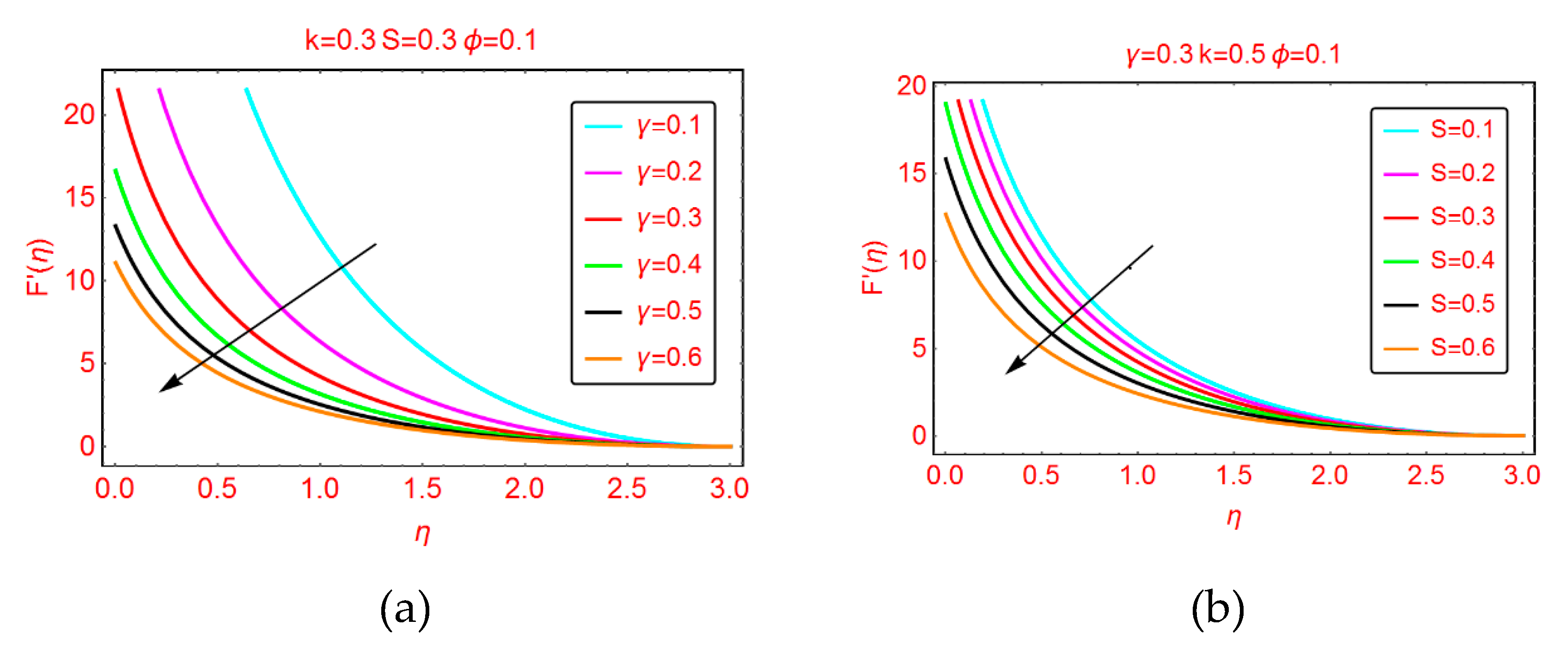
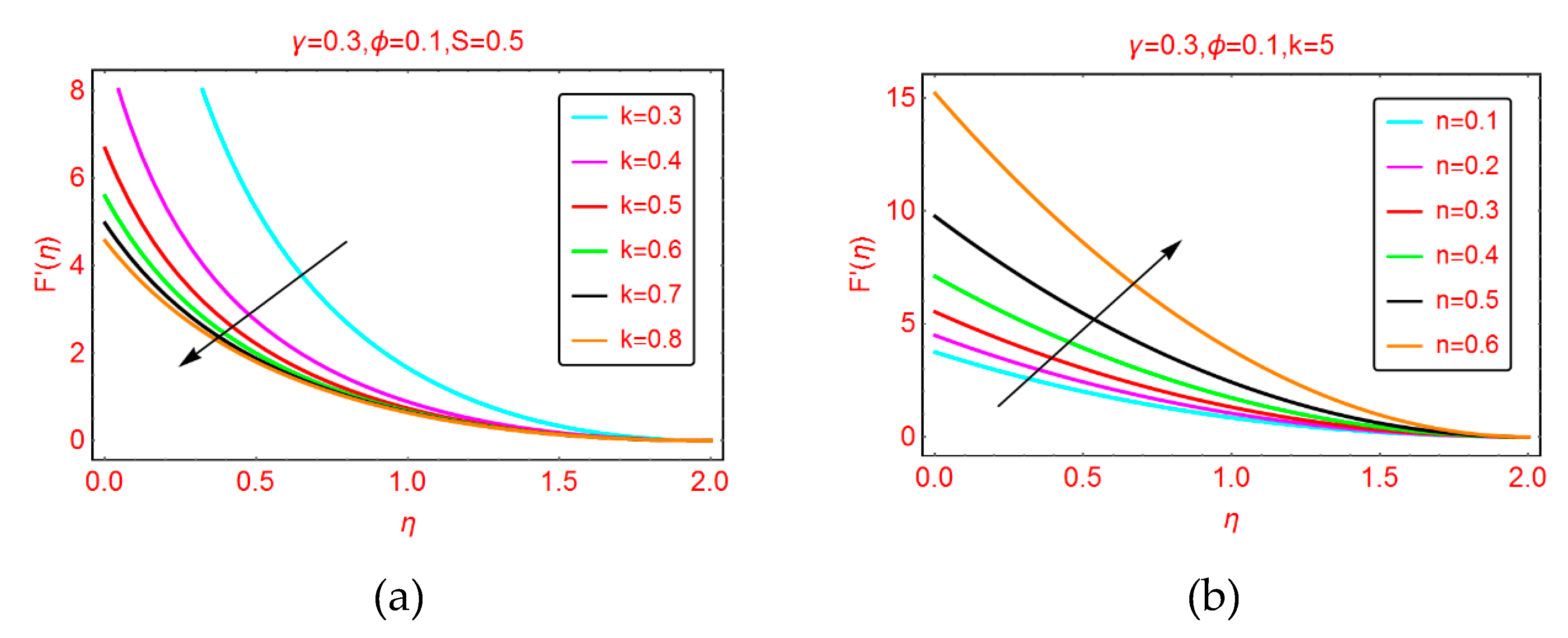
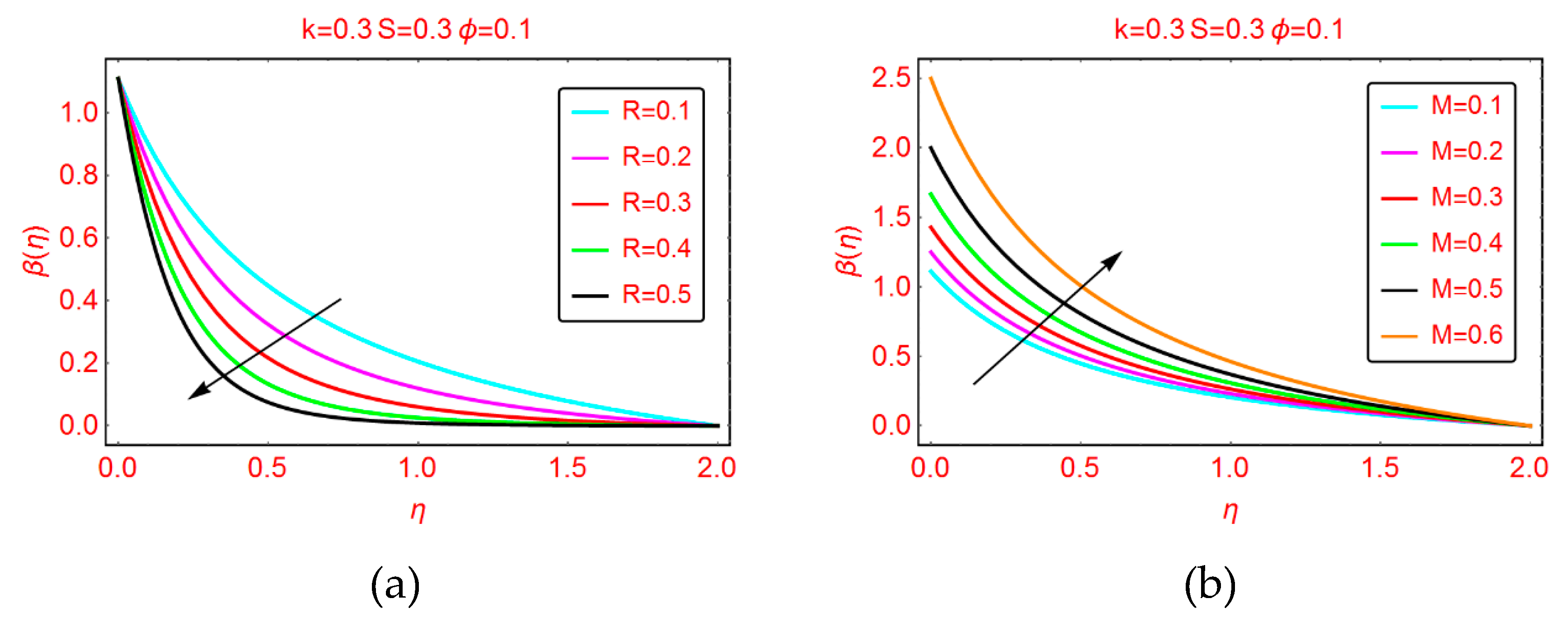
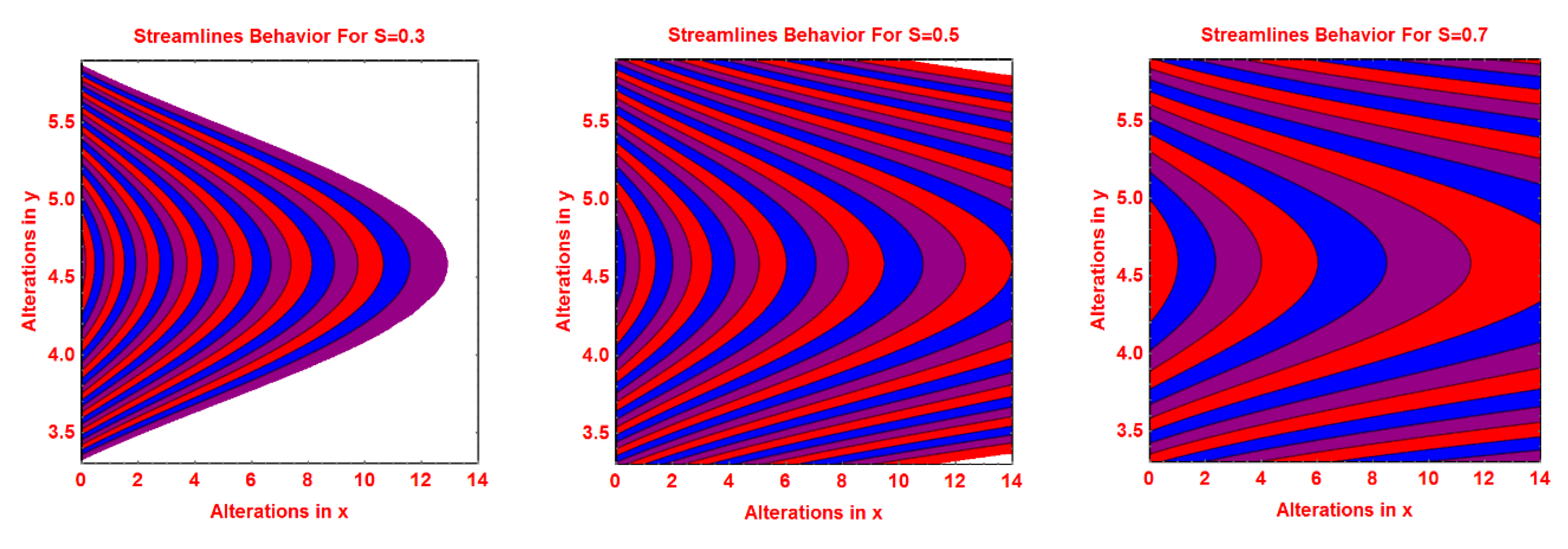
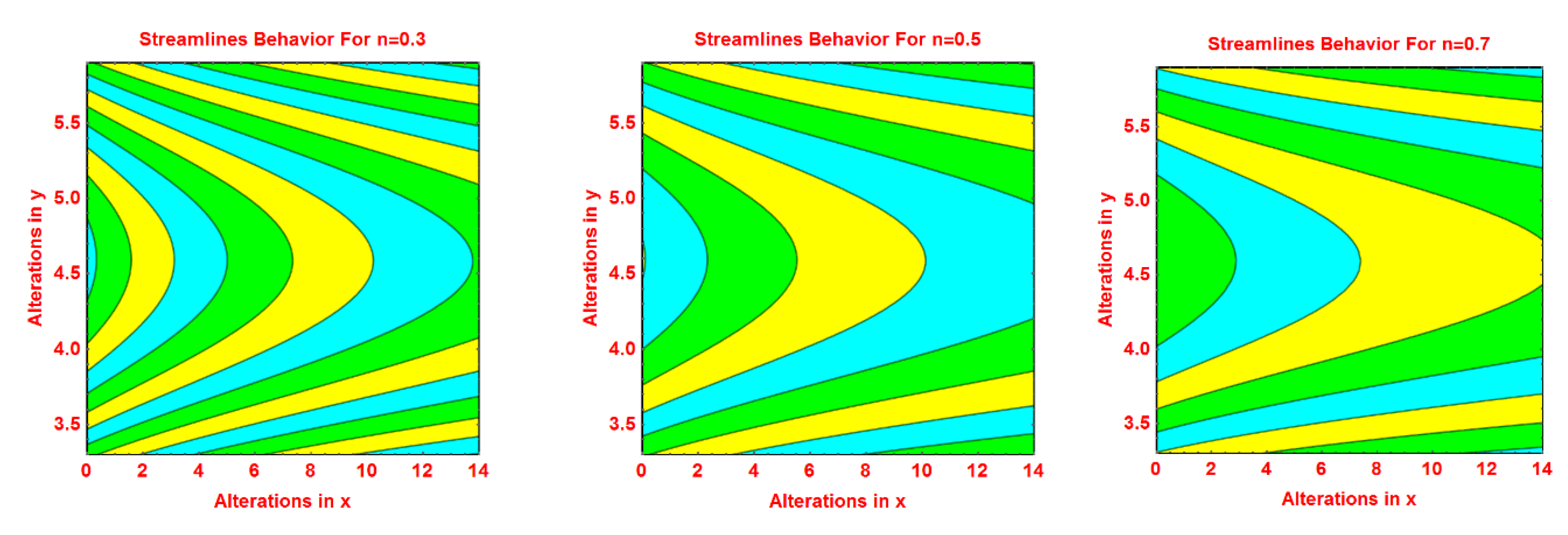
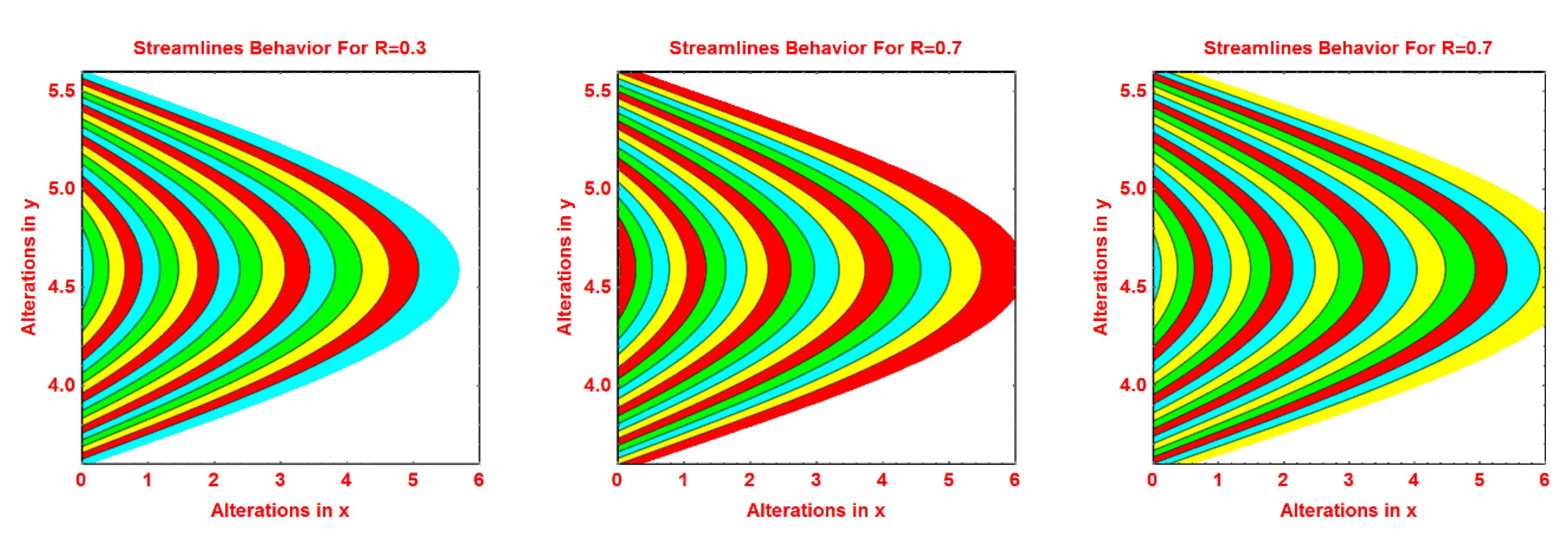

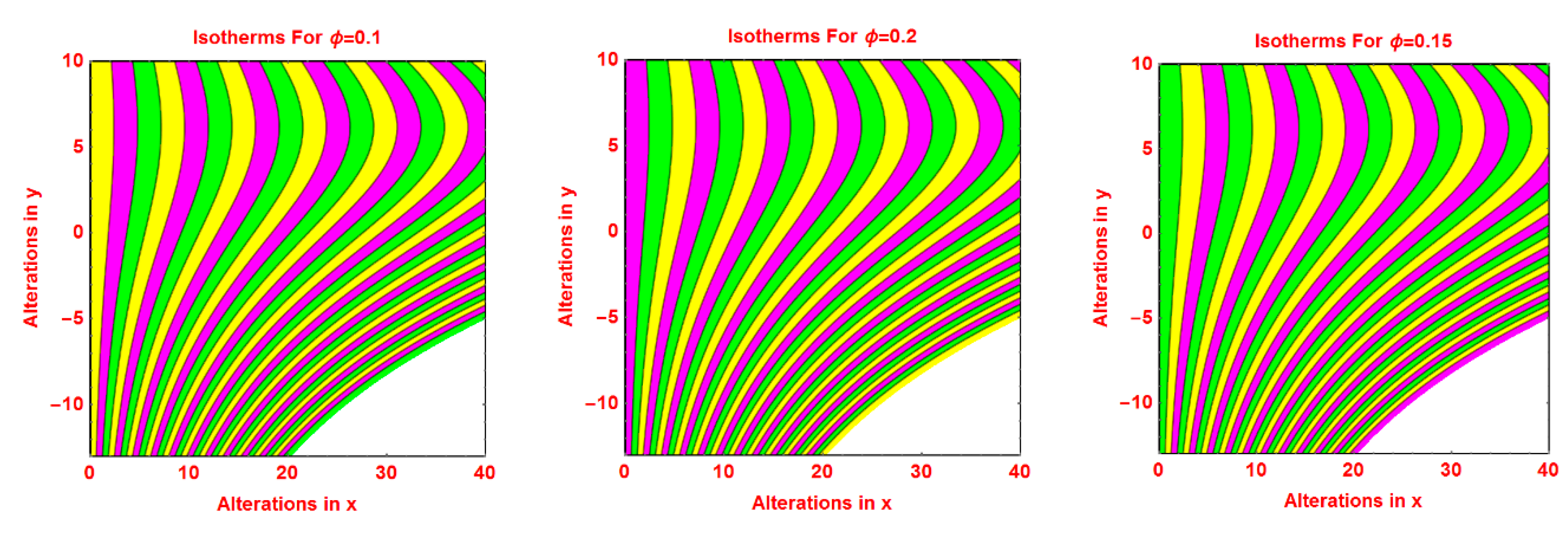
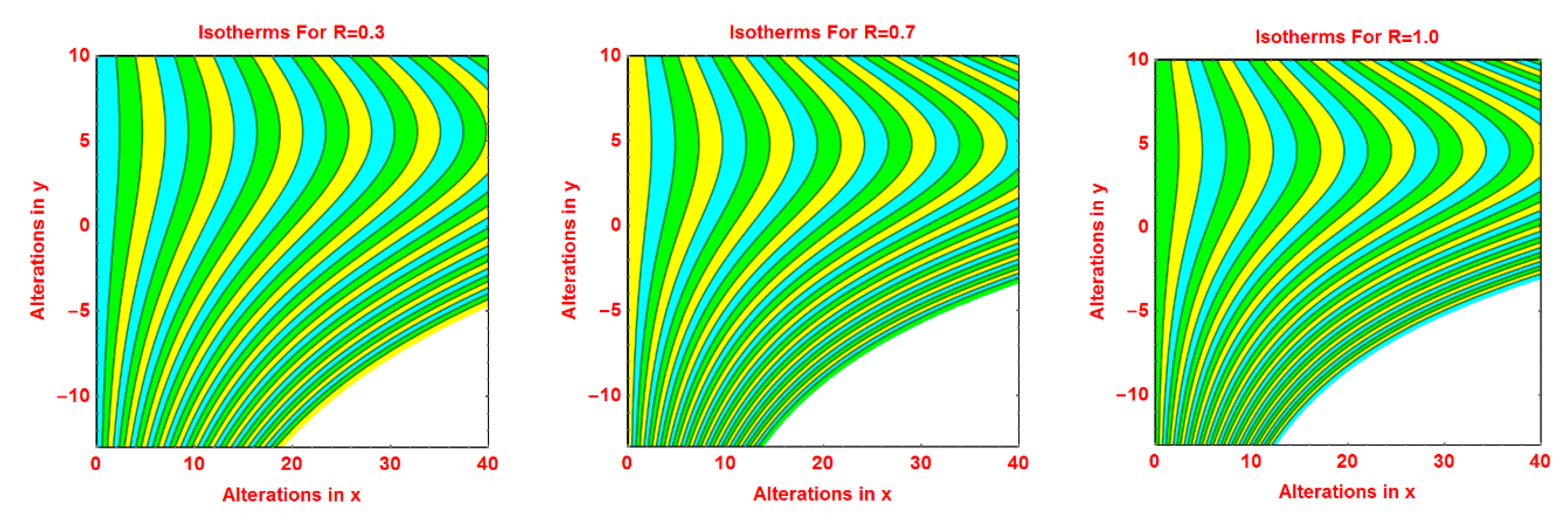
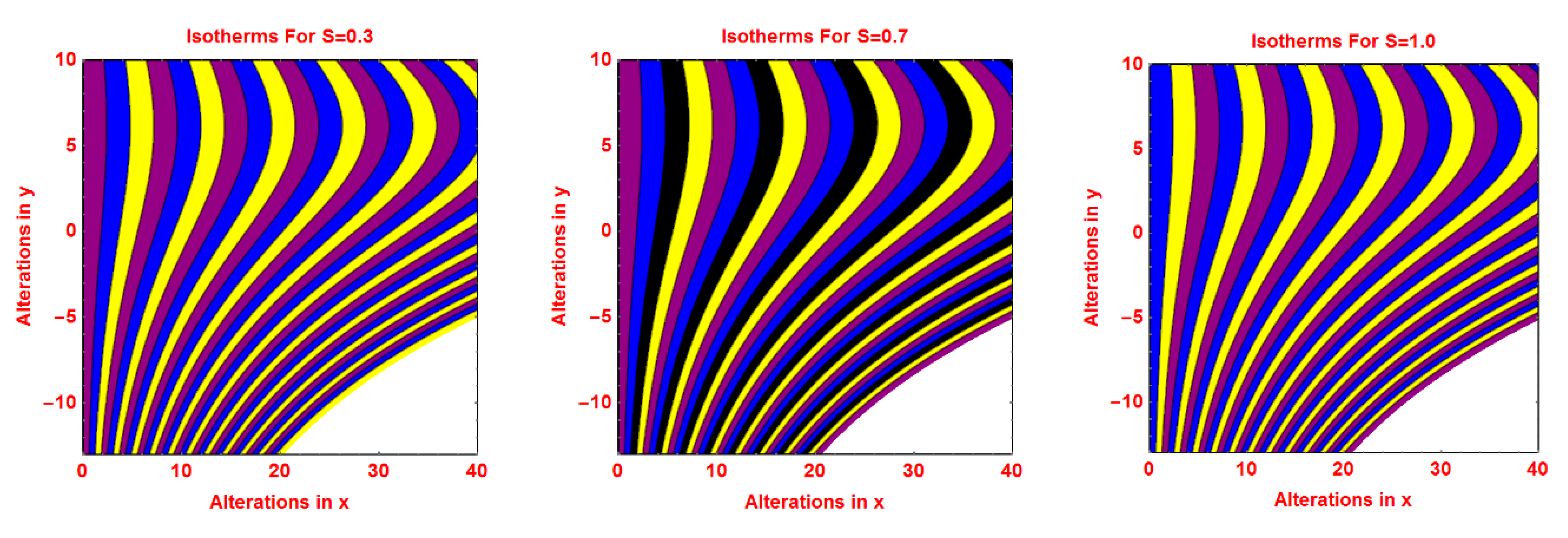
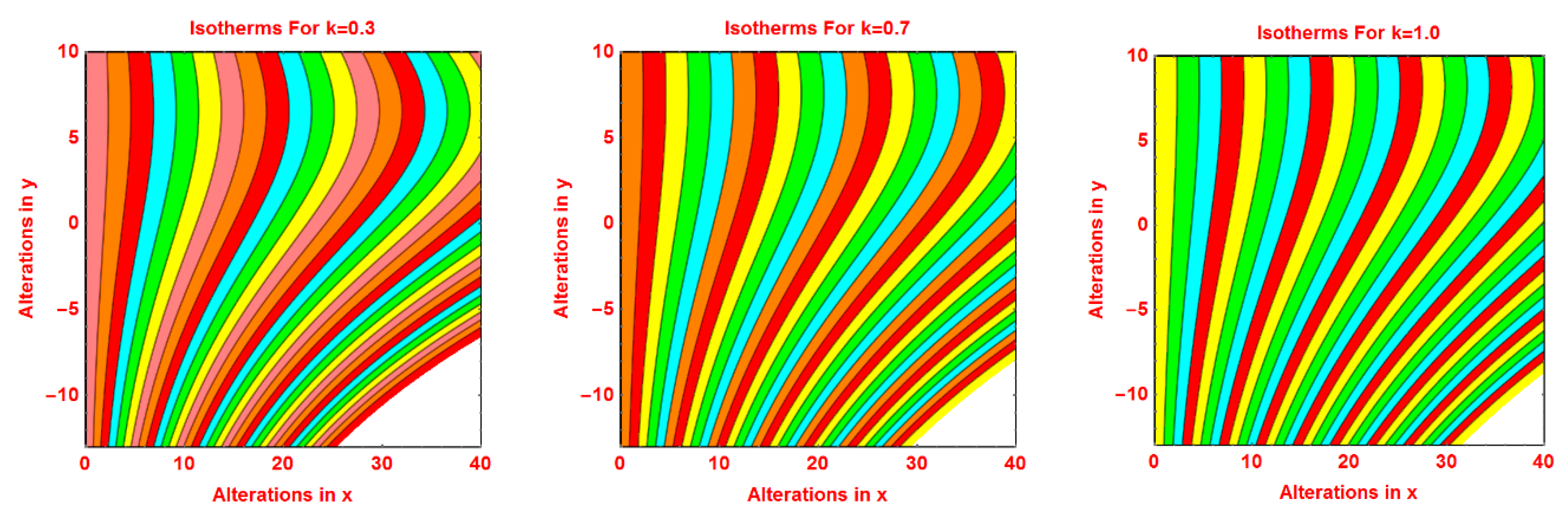

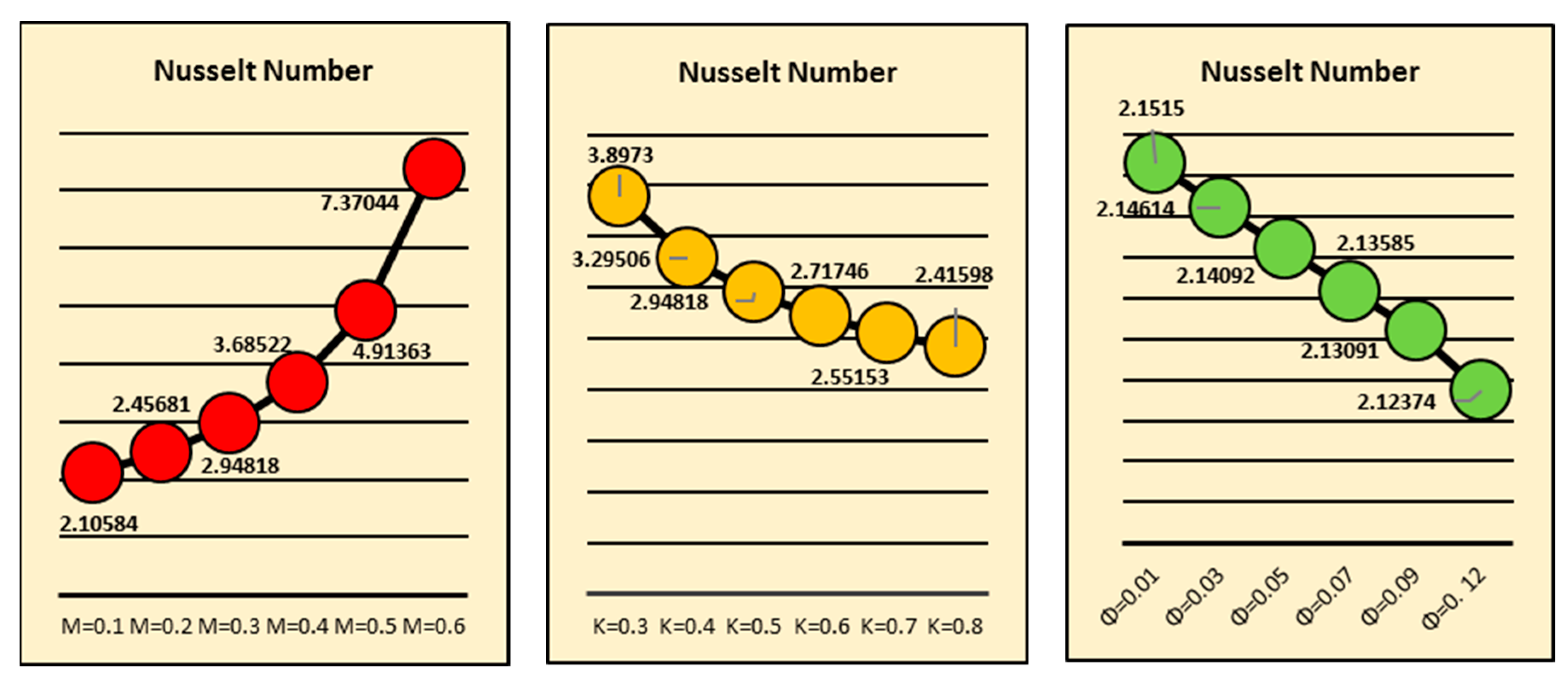

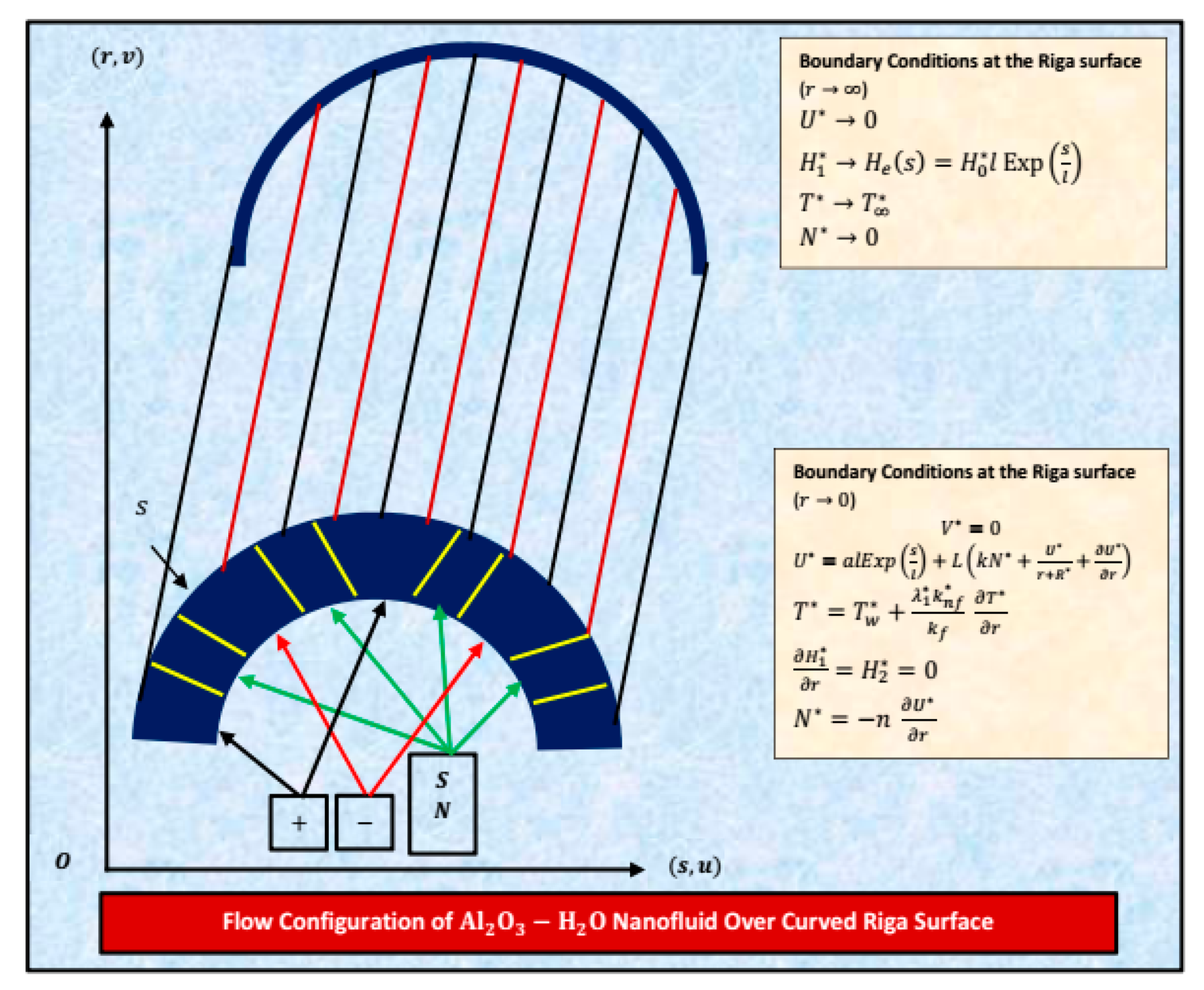
| k | Sajid et al. [21] | Present |
|---|---|---|
| 5 | 0.75763 | 0.757631 |
| 10 | 0.87349 | 0.873489 |
| 20 | 0.93561 | 0.93561 |
| 30 | 0.95686 | 0.970198 |
| 40 | 0.96759 | 0.942587 |
| 50 | 0.97405 | 0.974049 |
| Properties | dp (nm) | ρ (kg/ m3) | β (1/k) | Cp (J/kg K) | μf (kg/ms) | k (W/mk) | σ (S/m) |
|---|---|---|---|---|---|---|---|
| H2O | 0.385 | 993 | 36.2 × 105 | 4178 | 695 × 106 | 0.628 | 0.005 |
| Al2O3 | 33 | 3970 | 0.85 × 105 | 765 | --------- | 40 | 0.05 × 106 |
© 2020 by the authors. Licensee MDPI, Basel, Switzerland. This article is an open access article distributed under the terms and conditions of the Creative Commons Attribution (CC BY) license (http://creativecommons.org/licenses/by/4.0/).
Share and Cite
Adnan; Zaidi, S.Z.A.; Khan, U.; Ahmed, N.; Mohyud-Din, S.T.; Chu, Y.-M.; Khan, I.; Nisar, K.S. Impacts of Freezing Temperature Based Thermal Conductivity on the Heat Transfer Gradient in Nanofluids: Applications for a Curved Riga Surface. Molecules 2020, 25, 2152. https://doi.org/10.3390/molecules25092152
Adnan, Zaidi SZA, Khan U, Ahmed N, Mohyud-Din ST, Chu Y-M, Khan I, Nisar KS. Impacts of Freezing Temperature Based Thermal Conductivity on the Heat Transfer Gradient in Nanofluids: Applications for a Curved Riga Surface. Molecules. 2020; 25(9):2152. https://doi.org/10.3390/molecules25092152
Chicago/Turabian StyleAdnan, Syed Zulfiqar Ali Zaidi, Umar Khan, Naveed Ahmed, Syed Tauseef Mohyud-Din, Yu-Ming Chu, Ilyas Khan, and Kottakkaran Sooppy Nisar. 2020. "Impacts of Freezing Temperature Based Thermal Conductivity on the Heat Transfer Gradient in Nanofluids: Applications for a Curved Riga Surface" Molecules 25, no. 9: 2152. https://doi.org/10.3390/molecules25092152
APA StyleAdnan, Zaidi, S. Z. A., Khan, U., Ahmed, N., Mohyud-Din, S. T., Chu, Y.-M., Khan, I., & Nisar, K. S. (2020). Impacts of Freezing Temperature Based Thermal Conductivity on the Heat Transfer Gradient in Nanofluids: Applications for a Curved Riga Surface. Molecules, 25(9), 2152. https://doi.org/10.3390/molecules25092152







